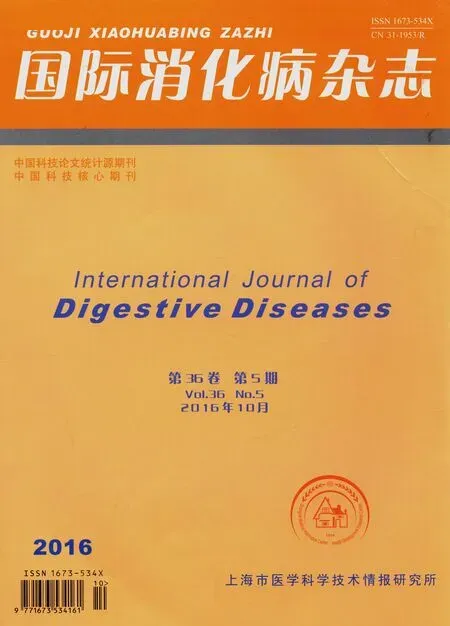利福昔明防治肠道疾病的作用机制及疗效的研究进展
刘 响 曹海龙 姜 葵 王邦茂
·综述·
利福昔明防治肠道疾病的作用机制及疗效的研究进展
刘 响 曹海龙 姜 葵 王邦茂
利福昔明(rifaixmin)是利福霉素衍生物,具有口服不吸收、抗菌活性较强和全身性不良反应较少等特点,近年来应用于细菌性腹泻、肠易激综合征(IBS)、炎症性肠病(IBD)及结肠憩室病等多种肠道疾病的治疗。研究发现利福昔明治疗肠道疾病的作用机制并不仅限于直接的抗菌作用,还包括减少细菌毒力及致病性、减少细菌对上皮细胞的黏附力、调节肠道免疫信号及激活孕烷X受体(PXR)等机制。该文就利福昔明在治疗肠道疾病中的作用机制及疗效的研究进展作一综述。
利福昔明;细菌感染性腹泻;肠易激综合征;炎症性肠病;结肠憩室病
利福昔明(rifaximin)是利福霉素的半合成衍生物,其抗菌谱较广、抗菌活性较强,通过与细菌中依赖DNA-β亚单位不可逆性结合从而抑制RNA合成,最终抑制细菌蛋白质的合成[1-2]。临床上对多种革兰阳性菌和革兰阴性菌有高度的抗菌活性,尤其是前者。动物实验和临床研究发现利福昔明口服不吸收[3],其通过杀灭肠道的病原体在局部发挥抗菌作用,适用于肠道感染。正因为利福昔明的局部抗菌作用,且与其他药物几乎无相互作用,耐受性良好,不易引起全身性不良反应[4],在防治急性肠道感染、幽门螺杆菌感染、肠易激综合征(IBS)、炎症性肠病(IBD)、结肠憩室病以及肝性脑病等常见消化系统疾病中的应用日趋增加,显示出一定的疗效[5-8]。本文就利福昔明在治疗肠道疾病中的作用机制及疗效的研究进展作一综述。
1 细菌感染性腹泻
利福昔明在肠道内吸收少,在粪便中的浓度较高[7],很容易获得较高的药物浓度起到杀灭肠道内细菌病原体的作用[4]。在最低抑菌浓度下,利福昔明可使热稳定性和热不稳定性肠毒素、表面黏附因子、基质金属蛋白酶-9(MMP-9)的表达下降,使炎性反应过程中细胞外基质蛋白和白细胞介素-8(IL-8)表达下调,并减少中性粒细胞的浸润[9]。另有研究发现,利福昔明可诱导细胞色素P450 3A4同功酶代谢,改变结肠菌群的定植情况[10]。因此,利福昔明治疗细菌感染性腹泻主要是通过减少致病性大肠杆菌的毒力因子和肠毒素的释放及抑制其产物的合成,从而降低细菌对肠黏膜的黏附作用及减轻黏膜炎性反应[11]。
一项关于利福昔明治疗急性腹泻的随机对照试验结果显示,利福昔明组第1次服药后至末次未成形大便的时间比安慰剂组明显缩短(利福昔明组中位数46 h,安慰剂组中位数68 h,P<0.001),并且利福昔明治疗急性腹泻的痊愈率、有效率及细菌清除率均比安慰剂组升高,不良反应发生率明显降低[12]。有研究显示,利福昔明对细菌性肠道感染的疗效与环丙沙星相似[2,10]。以往研究发现,利福昔明不仅在治疗细菌感染性腹泻中的应用有潜在价值,还可通过增加健康菌群的丰度及改变细菌代谢成分,从而安全有效地预防由产毒性大肠埃希菌引起的急性旅行者腹泻的发生[13]。
此外,利福昔明可明显改变C型艰难梭菌的毒力,还可预防艰难梭菌感染所致腹泻的复发[14]。虽然利福昔明对于艰难梭菌感染有一定的疗效,但由于研究的样本量较小,使用剂量和服用时间尚不确定,仍需大量临床数据支持。
2 IBS
IBS是一种常见的功能性胃肠疾病,其发病机制尚不明确,主要包括异常的肠道动力、内脏高敏感及肠道菌群失调等[15-16],近年来有证据表明服用短疗程利福昔明可使IBS的症状显著改善[17],可能的作用机制如下。
2.1 抑制小肠细菌过度生长
研究显示20%~30%的IBS患者存在小肠细菌过度生长(SIBO)[18],利福昔明可通过改善SIBO进而改善非便秘型IBS患者的腹部症状[19]。有研究发现,在567例IBS患者中,117例可诊断为SIBO,并可分离出170种需氧菌,并且证实利福昔明在体外可抑制其中大肠杆菌、粪肠球菌及金黄葡萄球菌的生长,还可抑制克雷白杆菌、肠杆菌、非肠杆菌革兰阴性菌,使肠道菌群发生改变,进而缓解IBS患者的腹部症状[20]。
2.2 重塑肠道微生态
由于利福昔明可以高度溶解于胆汁,使其在小肠内有高度溶解性,进而可重塑肠道环境中微生物的多样性[21]。在慢性应激诱导的小鼠内脏高敏感模型中,利福昔明可降低小鼠结肠中细菌总数,细菌的16sRNA下降,在门水平上肠道微生态的改变不明显,而在属水平上有明显的改变,如减少梭菌属和消化道链球菌属的丰度,增加乳酸杆菌的丰度[22]。还有研究发现,口服利福昔明可升高细菌代谢产生的饱和脂肪酸、非饱和脂肪酸及碳水化合物水平,纠正肠道微生态失衡,进而改善肠道症状。
2.3 调节肠道炎性反应及内脏高敏感
研究发现,利福昔明可通过增加乳酸杆菌的丰度和减少丝状杆菌数量从而改善因慢性应激诱导的黏膜炎性反应和肠道屏障功能[23]。在肠道菌群中乳酸杆菌占主导时,可使慢性避水应激诱导后的小鼠的促炎因子IL-6和肿瘤坏死因子-α(TNF-α)的mRNA水平下降,减少中性粒细胞和单核细胞的黏膜浸润,减少炎性细胞在固有层的浸润;进一步研究发现,利福昔明可预防压力诱导后的肠上皮紧密连接蛋白ZO-1的mRNA及蛋白的减少,修复肠道完整性,从而预防慢性心理应激诱发的内脏痛觉过敏[22]。
2.4 有效性评价
最近的Meta分析发现,对于治疗后及随访期间患者,利福昔明可显著缓解IBS整体症状(治疗后OR=1.19,95%CI:1.08~1.32;随访期间OR=1.36,95%CI:1.18~1.58,P<0.05),纳入研究的干预人群大多为非便秘型IBS。在随访时腹胀感明显减轻,而刚治疗结束时并未明显减轻;腹痛、恶心、呕吐及头痛等症状在两组中并未见明显差异。该研究认为利福昔明对于缓解试验组腹部整体症状的疗效好于安慰剂组[24]。有研究报道1例便秘患者服用利福昔明后,可通过减少甲烷排出、促进肠道蠕动以及粪便形状改变,进而缓解慢性便秘症状[25]。因此,利福昔明对IBS各亚型具有潜在疗效。
另有证据显示,利福昔明联合新霉素治疗比新霉素单独治疗便秘型或混合型IBS的疗效更明显,进一步研究发现新霉素与利福昔明联合治疗组通过减少呼出甲烷的水平而改善便秘型IBS[26]。新霉素虽可以改变回肠菌群,但并不能预防应激引起的肠道炎性反应和内脏高敏感[22],因而提示利福昔明在IBS的应用中更具有优势。
3 IBD
IBD是一种病因未明的慢性非特异性肠道炎性疾病,主要包括溃疡性结肠炎(UC)和克罗恩病(CD),发病机制尚不十分明确。肠道菌群在诱导IBD的炎性反应发生中起着重要的作用,主要证据来源于CD及结肠炎在抗生素治疗中可获益,并且肠道感染可引起UC活动[5,27]。以往研究已发现利福昔明有抗炎作用,因此将利福昔明作为活动期IBD的治疗用药具有理论依据。
为明确利福昔明治疗IBD的作用机制,有研究发现利福昔明可作为孕烷X受体(PXR)激动剂,通过刺激PXR使p38丝裂原活化蛋白激酶(MAPK)活化,进而增强被破坏的肠上皮的愈合能力,改善肠壁通透性,促进肠道屏障的修复[28]。随后也有证据证实,在胃肠道中,利福昔明选择性激动PXR,调节药物解毒作用相关基因的表达,PXR活化可通过核因子-κB(NF-κB)和c-Jun氨基端激酶(JNK)通路来调节免疫反应,抑制炎性反应[29]。此外,在机体代谢过程中,利福昔明激活PXR可调节外源性物质氧化、特定结合酶及转运体的表达,消除机体潜在的有害化学物质[30]。
另一方面,利福昔明还可有效诱导CD和UC缓解并预防复发。一项临床试验表明,传统治疗后的168例CD患者每日服用利福昔明800 mg维持治疗,12周后可使症状缓解(CD缓解率:实验组100%,安慰剂组84%)[31],而且服药周期延长组患者12周后IBD的复发率降低,而延长24周后复发率降低但无统计学差异。有研究报道利福昔明和甲硝唑联合应用可缓解难治性UC,并可预防术后复发的风险[32]。由于对于IBD的治疗作用的研究仅限于小样本,今后需大样本的随机对照试验来验证利福昔明在IBD治疗中的有效性。
4 结肠憩室病
结肠憩室病在西方国家是一种常见的肠道疾病,治疗目的是减轻症状和避免并发症发生。有研究发现,单用利福昔明对单纯症状性憩室病的缓解率约高于单用高纤维饮食的30%[33],1 003例患者每月7~10 d服用利福昔明,周期为3个月,结果发现可有效缓解单纯性结肠憩室病患者的症状,防止并发症发生[34]。另有研究发现,对于结肠憩室病的症状缓解,利福昔明与美沙拉嗪的差异并无统计学意义[35]。然而利福昔明治疗憩室病的机制尚不清楚,可能由于利福昔明可减弱肠道菌群的代谢活动,或是由于粪便滞留在憩室中导致肠道中细菌过度生长,均可加剧纤维素的分解及产气活动,目前尚缺乏动物模型研究的验证。
5 结语
作为一个广谱非吸收性的利福霉素类抗菌药物,利福昔明很少影响肠道正常菌群,并且与其他药物几乎没有相互作用,因而不易引起全身性不良反应,安全性较好,已在多种肠道疾病中表现出良好的疗效,其作用机制并非局限于直接的杀菌作用,还包括减少细菌毒力、改变细菌定植情况、改善肠道微生态、抗炎反应、改善肠道屏障功能、降低内脏高敏感及刺激PXR等方面。然而利福昔明的使用剂量、时间和长期应用的安全性,以及在临床亚型中的应用疗效差异等问题仍需进行探索。因此,需要更多的分子机制研究和更广泛的随机对照试验来评价利福昔明治疗肠道疾病的临床价值,进而获得更多的循证医学证据。
1 Corsetti M, Whorwell P. Novel pharmacological therapies for irritable bowel syndrome[J]. Expert Rev Gastroenterol Hepatol, 2016, 10: 807-815.
2 Ramos JM, Vidal I, Bellot P, et al. Comparison of the in vitro susceptibility of rifaximin versus norfloxacin against multidrug resistant bacteria in a hospital setting. A proof-of-concept study for use in advanced cirrhosis[J]. Gut, 2016, 65: 182-183.
3 Eltawil KM, Laryea M, Peltekian K, et al. Rifaximin vs. conventional oral therapy for hepatic encephalopathy: a meta-analysis[J]. World J Gastroenterol, 2012, 18: 767-777.
4 Calanni F, Renzulli C, Barbanti M, et al. Rifaximin: beyond the traditional antibiotic activity[J]. J Antibiot (Tokyo), 2014, 67: 667-670.
5 Nitzan O, Elias M, Peretz A, et al. Role of antibiotics for treatment of inflammatory bowel disease[J]. World J Gastroenterol, 2016, 22: 1078-1087.
6 Bajaj JS. Review article: potential mechanisms of action of rifaximin in the management of hepatic encephalopathy and other complications of cirrhosis[J]. Aliment Pharmacol Ther, 2016, 43(Suppl 1): 11-26.
7 Bielaszewska M, Idelevich EA, Zhang W, et al. Effects of antibiotics on Shiga toxin 2 production and bacteriophage induction by epidemicEscherichiacoliO104: H4 strain[J]. Antimicrob Agents Chemother, 2012, 56: 3277-3282.
8 Alajbegovic S, Sanders JW, Atherly DE, et al. Effectiveness of rifaximin and fluoroquinolones in preventing travelers′diarrhea (TD): a systematic review and meta-analysis[J]. Syst Rev, 2012, 1: 39.
9 Jiang ZD, Ke S, Dupont HL. Rifaximin-induced alteration of virulence of diarrhoea-producingEscherichiacoliandShigellasonnei[J]. Int J Antimicrob Agents, 2010, 35: 278-281.
10 Hong KS, Kim JS. Rifaximin for the treatment of acute infectious diarrhea[J]. Therap Adv Gastroenterol, 2011, 4: 227-235.
11 DuPont HL. Review article: the antimicrobial effects of rifaximin on the gut microbiota[J]. Aliment Pharmacol Ther, 2016, 43(Suppl 1): 3-10.
12 DuPont HL, Petersen A, Zhao J, et al. Targeting of rifamycin SV to the colon for treatment of travelers′ diarrhea: a randomized, double-blind, placebo-controlled phase 3 study[J]. J Travel Med, 2014, 21: 369-376.
13 Hu Y, Ren J, Zhan M, et al. Efficacy of rifaximin in prevention of travelers′diarrhea: a meta-analysis of randomized, double-blind, placebo-controlled trials[J]. J Travel Med, 2012, 19:352-356.
14 Joseph J, Singhal S, Patel GM, et al.Clostridiumdifficilecolitis: review of the therapeutic approach[J]. Am J Ther, 2014, 21: 385-394.
15 Mayer EA, Savidge T, Shulman RJ. Brain-gut microbiome interactions and functional bowel disorders[J]. Gastroenterology, 2014, 146: 1500-1512.
16 左秀丽. 肠易激综合征病因及发病机制[J]. 中华消化杂志, 2015, 35: 434-438.
17 Saadi M, McCallum RW. Rifaximin in irritable bowel syndrome: rationale, evidence and clinical use[J]. Ther Adv Chronic Dis, 2013, 4: 71-75.
18 Shimura S, Ishimura N, Mikami H, et al. Small intestinal bacterial overgrowth in patients with refractory functional gastrointestinal disorders[J]. J Neurogastroenterol Motil, 2016, 22: 60-68.
19 Schoenfeld P, Pimentel M, Chang L, et al. Safety and tolerability of rifaximin for the treatment of irritable bowel syndrome without constipation: a pooled analysis of randomised, double-blind, placebo-controlled trials[J]. Aliment Pharmacol Ther, 2014, 39: 1161-1168.
20 Pistiki A, Galani I, Pyleris E, et al. In vitro activity of rifaximin against isolates from patients with small intestinal bacterial overgrowth[J]. Int J Antimicrob Agents, 2014, 43: 236-241.
21 Pimentel M. Review article: potential mechanisms of action of rifaximin in the management of irritable bowel syndrome with diarrhoea[J]. Aliment Pharmacol Ther, 2016, 43(Suppl 1): 37-49.
22 Xu D, Gao J, Gillilland M 3rd, et al. Rifaximin alters intestinal bacteria and prevents stress-induced gut inflammation and visceral hyperalgesia in rats[J]. Gastroenterology, 2014, 146: 484-496.
23 Gao J, Gillilland MG 3rd, Owyang C. Rifaximin, gut microbes and mucosal inflammation: unraveling a complex relationship[J]. Gut Microbes, 2014, 5: 571-575.
24 Li J, Zhu W, Liu W, et al. Rifaximin for irritable bowel syndrome: a meta-analysis of randomized placebo-controlled trials[J]. Medicine (Baltimore), 2016, 95: e2534.
25 Ghoshal UC, Srivastava D, Verma A, et al. Slow transit constipation associated with excess methane production and its improvement following rifaximin therapy: a case report[J]. J Neurogastroenterol Motil, 2011, 17: 185-188.
26 Sachdeva S, Kondala R, Dahale AS, et al. Antibiotic treatment of constipation-predominant irritable bowel syndrome: the puzzle is yet to be solved[J]. Dig Dis Sci, 2014, 59: 2836-2837.
27 Nitzan O, Elias M, Peretz A, et al. Role of antibiotics for treatment of inflammatory bowel disease[J]. World J Gastroenterol, 2016, 22: 1078-1087.
28 Terc J, Hansen A, Alston L, et al. Pregnane X receptor agonists enhance intestinal epithelial wound healing and repair of the intestinal barrier following the induction of experimental colitis[J]. Eur J Pharm Sci, 2014, 55: 12-19.
29 Hirota SA. Understanding the molecular mechanisms of rifaximin in the treatment of gastrointestinal disorders-a focus on the modulation of host tissue function[J]. Mini Rev Med Chem, 2015, 16: 206-217.
30 Wan YC, Li T, Han YD, et al. Effect of pregnane xenobiotic recptor activation on inflammatory bowel disease treated with rifaximin[J]. J Biol Regul Homeost Agents, 2015, 29: 401-410.
31 Jigaranu AO, Nedelciuc O, Blaj A, et al. Is rifaximin effective in maintaining remission in Crohn′s disease[J]. Dig Dis, 2014, 32: 378-383.
32 Goldberg ND, Vadlamudi A, Parrish N. Treatment of refractory Crohn′s disease and pyoderma gangrenosum with a combination regimen of rifaximin, gentamicin and metronidazole[J]. Case Rep Gastroenterol, 2015, 9: 25-28.
33 Moretti A, Spagnolo A, Mangone M, et al. Role of rifaximin in the treatment of colonic diverticular disease[J]. Clin Ter, 2012, 163: 33-38.
34 Stallinger S, Eller N, H genauer C. Non-interventional study evaluating efficacy and tolerability of rifaximin for treatment of uncomplicated diverticular disease[J]. Wien Klin Wochenschr, 2014, 126(1-2): 9-14.
35 Tursi A, Elisei W, Giorgetti GM, et al. Effectiveness of different therapeutic strategies in preventing diverticulitis recurrence[J]. Eur Rev Med Pharmacol Sci, 2013, 17: 342-348.
(本文编辑:林磊)
国家自然科学基金(81300272,81570478)
300052 天津医科大学总医院消化科
曹海龙,Email: cao_hailong@163.com
10.3969/j.issn.1673-534X.2016.05.005
2016-04-25)

